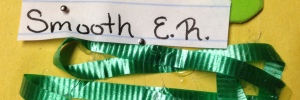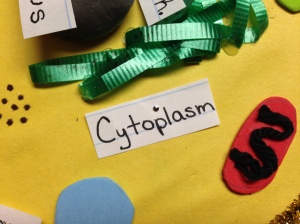I decided to demonstrate an animal cell. I made my model using half of a foam sphere, construction paper, foam, twine, yarn, clay, markers, and pipe cleaners. The organelles found in animal cells include a nucleus, plasma membrane, endoplasmic reticulum (rough and smooth), Golgi body, cytoplasm, vacuoles, mitochondrias, ribosomes, and lysosomes.
The nucleus is represented by a clay ball in the center of my model. The nucleus controls everything that happens in the cell. It contains the chromosomes, which contain DNA and genetic materials. The nucleus controls the cell’s growth and reproduction. It is surrounded by a nuclear envelope, which separates the contents of the nucleus from the cytoplasm of the cell. The nucleus also contains a nucleolus and nuclear pores, which allow nucleic acids and proteins to move in and out of the nucleus.
The plasma membrane is represented by the gold pipe cleaners. It covers the whole cell. It is a semi-permeable membrane that can allow substances to go in and out of a cell, but it can also block substances from entering and leaving the cell. It holds the shape of the cell. It keeps the contents of the cell inside so that it doesn’t get mixed up with the outside environment.
The endoplasmic reticulum is represented by the green ribbon. It is connected to the nucleus and extends through the cytoplasm. It contains two regions: the rough ER and the smooth ER. The rough ER is covered with ribosomes, which are the black dots on the green ribbon. It is a system of flattened sacs that makes membranes and secretory proteins. In different parts of the body, it can make antibodies and insulin. The smooth ER does not have ribosomes on it and is a system of tubes. It can make carbohydrates, lipids, steroids, enzymes, proteins, and male and female hormones. It can help muscle cells contract in muscles.
The Golgi body is represented by the twine. It is known as the “manufacturing and shipping center” of the cell. It is also flat sacs that make, store, and ship cell products. It takes simple molecules and combines them to make complex molecules, packages them into vesicles and then either sends them to other parts of the cells or stores them for later use. It also builds lysosomes. It works along with the ER.
The cytoplasm is represented by the yellow construction paper that covers the whole model. It is all of the contents of the cell inside the plasma membrane and outside of the nucleus. It contains the organelles in the cell. It is clear and gel-like. It is mostly made up of water and also can contain salt and enzymes. The cytoplasm assists in moving materials around the cell and dissolving cellular wastes.
The vacuoles are represented by the blue foam circles. They are “storage bubbles” in cells. They can store the food, nutrients, or water that a cell needs to survive. They can also store wastes so that they don’t harm the rest of the cell. Vacuoles are simply just fluid surrounded by a membrane.
The mitochondrias are represented by the red foam ovals with black yarn on them. They are the power source for the cells. They convert energy into forms that the cell can use. Cellular respiration, division, growth, and death happen in these organelles. They have double membranes with a protein inside. The inner membranes have folds which can increase surface area and the productivity of cellular respiration.
Ribosomes are represented by the little black dots. They are found in the cytoplasm and on the rough ER. They contain proteins and RNA and build the proteins in the cells. There can be small numbers of ribosomes, or there can be millions of them. Protein synthesis happens in these ribosomes.
Lysosomes are represented by the small, green circles. They are membrane sacs that are filled with enzymes. They are made by the ER and Golgi body. Lysosomes are able to digest nucleic acids, fats, polysaccharides, and proteins. They recycle cell material. They also break down the cell when it dies. They break down the complex molecules and digest them.











Leave a comment